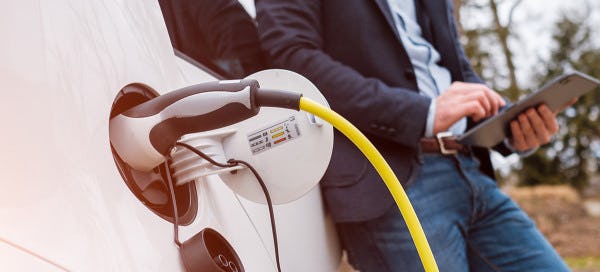The United States power grid is seeing more and more blackouts, and each of these outages seems to be more devastating—in February of 2021, millions of Texans were left without power for days at a time during a freak winter storm.
The mass adoption of electric vehicles (EVs) will only put more strain on the grid, as owners of these cars will be charging up instead of gassing up. While renewable energy is needed to help balance out the grid and prevent things like a power outage, other technology will also need to be introduced to help reduce the strain that electric vehicles will put on the grid.
How Can Vehicle-to-Grid Help?
Vehicle-to-grid (V2G) technology allows electric vehicles to provide important load balancing for our power grids, in addition to their obvious use as transportation. Through the help of bidirectional charging stations, electric vehicles can both take in power and send it back into the grid as needed. V2G serves two basic functions to assist the grid: valley filling and peak shaving.
‘Valley filling’ refers to the ability of electric cars to only charge at low-demand hours, usually overnight. ‘Peak shaving’ occurs when an electric vehicle sends power or stored energy back into the grid at peak hours, helping to balance out the immense load on the system. There are a few sub-categories of V2G currently being tested and used around the world, including V2H, V2B, and V2X technologies.
Vehicle-to-Home
Vehicle-to-home (V2H) technology refers to an electric car’s ability to serve as a residential backup power source during power outages. Alternatively, V2H can also be used as a renewable energy source on a consistent basis, reducing your energy costs and reliance on the grid. Solar power can be harvested and stored in an electric vehicle until it is needed.
Vehicle-to-Building
Vehicle-to-building (V2B) serves the same function as V2H, but on a larger scale for businesses and commercial buildings. For instance, a company may have a fleet of electric cars that are not always in use. While they sit at the charging station, they can also be balancing out the building’s energy usage, or even supplementing the power usage and reducing energy costs. This is being tested on a large scale in the United States, like this trial implemented at the Alliance Center in Denver, Colorado.
Vehicle-to-Everything (V2X)
Vehicle-to-everything (V2X) is a catch-all term for the above technologies, referring to an electric vehicle's ability to provide power to everything. This includes homes, businesses, and more.
V2G vs Smart Charging
Some of the ideas of V2G are present in the unidirectional charging, also referred to as smart charging or V1G. Regular smart charging adjusts the charging power based on the electric grid’s current usage. If you attempt to charge your electric vehicle during peak hours, you may receive a slightly slower charge to help prevent any overloading of your area’s power grid.
V2G takes this a step further, by sending power from your electric car back into the grid, which helps regulate spikes in energy usage. With enough electric vehicles capable of V2G, a city’s grid can better embrace peak energy hours and even power outages. So electric cars could help to keep the grid alive for at least a short time while the power company fixes downed lines or other issues.
Current Implementation by Country
V2G technology has been implemented in different countries around the world, but it still remains a largely theoretical solution in most places (including the United States). With more testing, plus cooperation and funding from state and local governments, we should see widespread adoption of V2G in the coming years.
United States
Small-scale testing and research of vehicle-to-grid tech is currently underway in the United States. Nissan has been working with Fermata Energy to use their LEAF electric vehicles to help power their facilities in Franklin, TN. In 2020, Fermata’s bidirectional V2G charging system was the first to be certified by the Standard for Bidirectional Electric Vehicle (EV) Charging System Equipment.
Other small projects have been tested, but the United States needs to pick up the pace on V2G implementation if they wish to take the strain off of an aging grid. For United States residents, there are many options to help lower our usage of fossil fuels while V2G gains traction; choosing renewable energy sources when possible is a great start.
Japan
Nuuve Corporation, a renewable energy company based in San Diego, is spearheading a campaign in Japan to increase the availability of V2G-enabled cars to consumers. They have received funding and support from Toyota Tsusho Corporation and the Chubu Electric Power Grid Co., Inc, a Transmission System Operator (TSO) in Japan. Using Toyota’s electric vehicles, such as the Prius PHEV, they are testing the capabilities of V2G technology and attempting to show its ability to reduce our reliance on fossil fuels.
Denmark
Nuuve has also been testing out vehicle-to-grid technology in Denmark. They are working with Danish grid operator Energinet and Danish Technical University (DTU) on a few projects with various electric vehicle manufacturers. Their primary project concerns a fleet of cars at Frederiksberg Forsyning that are used during the day and parked overnight and on weekends. Over a two-year period, each car contributed around $2,000 to market revenue. If implemented on a wider scale, this would allow Nuuve to lower the cost of EV ownership for consumers.
UK
Octopus Energy, a British renewable energy provider, is running trials on domestic V2G implementation. They use Nissan LEAF electric vehicles and their proprietary Powerloop charger in an attempt to provide relief to the UK’s power grid.
Types of Vehicles Compatible with Vehicle-to-Grid
In the United States, there are currently no EVs capable of V2G. Most electric cars are capable of V1G, or unidirectional smart charging, but that’s where the innovation has stopped. Electric vehicles capable of smart charging include the Tesla Model 3, Chevrolet Bolt, BMW i3, and many more.
The Nissan LEAF electric vehicle has seen the most testing and news related to vehicle-to-grid implementation. However, in the United States, V2G is not yet available for residential Nissan LEAF owners. Other countries are setting up V2G systems around the LEAF, including the French utility company EDF. The company is working with Nissan to set up V2G for electric vehicle fleets, which will hopefully lower overall energy costs for these businesses. In recent years, Nissan was also testing the LEAF’s V2G capabilities at their Tennessee and San Diego offices.
Tesla sells the Powerwall in the United States, a backup power system that serves a similar function as V2H technology. These battery banks store a house’s solar power and allow the home to continue running as normal during power outages. Unfortunately, it does not yet integrate with the massive batteries that are found in every Tesla EV, although this could be a new feature in the near future.
The Benefits of Vehicle-to-Grid
The most obvious benefit of vehicle-to-grid tech is the effects it will have on the grid. In recent years, blackouts have become more frequent and more catastrophic, causing many to call on the government to step in and support solutions like renewable energy sources and vehicle-to-grid technology.
Although it will require large upfront costs, such as the installation of bidirectional charging stations and the necessary integration with the grid, the effects could be tremendous. Short power outages could be prevented altogether, while the devastating effects of widespread outages could be lessened, especially for homeowners who can keep their house running with a V2H-enabled electric vehicle.
Businesses and commercial buildings with electric vehicle fleets can see massive savings, as well as promoting ‘green’ operations. Most fleet vehicles are only used during regular business hours, so they sit unused overnight and on weekends. These electric cars could be plugged into the system to help balance the area’s power grid loads during peak hours, and state and local governments can provide financial incentives for businesses that choose to participate.
Moving Forward with V2G Technology
The support and innovation surrounding vehicle-to-grid technology is promising, and we’re excited to see where this initiative goes in the future. Along with other energy-related initiatives, V2G could play an important role in stabilizing the failing power grid that continues to effect the United States. Additionally, the technology could assist in the country’s transition to widespread adoption of electric vehicles and renewable energy.



